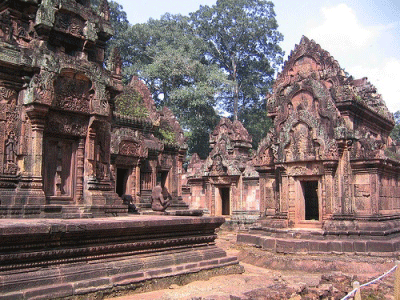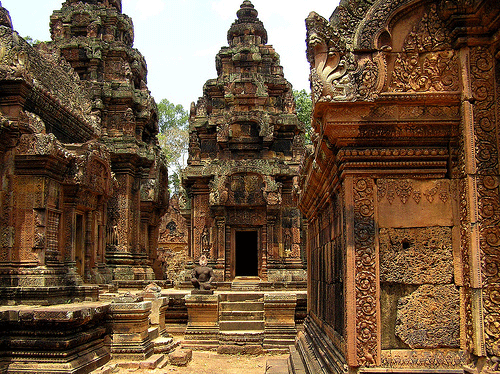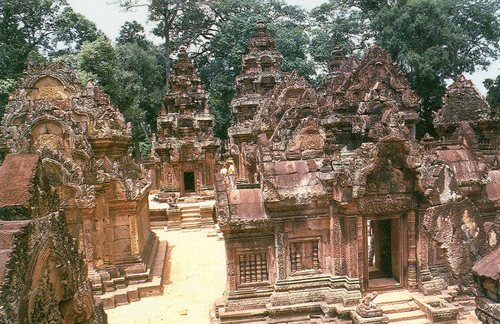History
Foundation and dedication
Consecrated in 967 A.D.[citation needed], Banteay Srei was the only major temple at Angkor not built by a monarch; its construction is credited to a courtier named Yajnavaraha, who served as a counsellor to king Rajendravarman. The foundational stela says that Yajnavaraha was a scholar and philanthropist who helped those who suffered from illness, injustice, or poverty. Originally, the temple was surrounded by a town called Isvarapura.
Yajnyavaraha’s temple was primarily dedicated to the Hindu god Shiva. Originally, it was carried the name Tribhuvanamahesvara — great lord of the threefold world — in reference to the Shaivite linga that served as its central religious image. However, the temple buildings appear to be divided along the central east-west axis between those buildings located south of the axis, which are devoted to Shiva, and those north of the axis, which are devoted to Vishnu.
The temple’s modern name, Banteay Srei — citadel of the women, or citadel of beauty — is probably related to the intricacy of the bas relief carvings found on the walls and the tiny dimensions of the buildings themselves. Some have speculated that it relates to the many devatas carved into the walls of the buildings.
Expansion and rededication
Banteay Srei was subject to further expansion and rebuilding work in the eleventh century. At some point it came under the control of the king and had its original dedication changed; an inscription of the early twelfth century records the temple being given to the priest Divarakapandita and being rededicated to Shiva. It remained in use at least until the fourteenth century.
Restoration
The temple was rediscovered only in 1914, and was the subject of a celebrated case of art theft when André Malraux stole four devatas in 1923 (he was soon arrested and the figures returned). The incident stimulated interest in the site, which was cleared the following year, and in the 1930s Banteay Srei was restored in the first important use of anastylosis at Angkor. Until the discovery of the foundation stela in 1936, it had been assumed that the extreme decoration indicated a later date than was in fact the case. To prevent the site from water damage, the joint Cambodian-Swiss Banteay Srei Conservation Project installed a drainage system between 2000 and 2003. Measures were also taken to prevent damage to the temples walls being caused by nearby trees. Unfortunately, the temple has been ravaged by pilfering and vandalism. When toward the end of the 20th century authorities removed some original statues and replaced them with concrete replicas, looters took to attacking the replicas. A statue of Shiva and his shakti Uma, removed to the National Museum in Phnom Penh for safekeeping, was assaulted in the museum itself.
Materials and style
Banteay Srei is built largely of a hard red sandstone that can be carved like wood. Brick and laterite were used only for the enclosure walls and some structural elements. The temple is known for the beauty of its sandstone lintels and pediments.
A pediment is the roughly triangular space above a rectangular doorway or openings. At Banteay Srei, pediments are relatively large in comparison to the openings below, and take a sweeping gabled shape. For the first time in the history of Khmer architecture, whole scenes of mythological subject-matter are depicted on the pediments.
A lintel is a horizontal beam spanning the gap between two posts. Some lintels serve a structural purpose, serving to support the weight of the superstructure, while others are purely decorative in purpose. The lintels at Banteay Srei are beautifully carved, rivalling those of the 9th century Preah Ko style in quality.
Noteworthy decorative motifs include the kala (a toothy monster symbolic of time), the guardian dvarapala (an armed protector of the temple) and devata (demi-goddess), the false door, and the colonette. Indeed, decorative carvings seem to cover almost every available surface. According to pioneering Angkor scholar Maurice Glaize, “Given the very particular charm of Banteay Srei — its remarkable state of preservation and the excellence of a near perfect ornamental technique — one should not hesitate, of all the monuments of the Angkor group, to give it the highest priority.” At Banteay Srei, wrote Glaize, “the work relates more closely to the art of the goldsmith or to carving in wood than to sculpture in stone”.
The site
Like most Khmer temples, Banteay Srei is oriented towards the east. It consists of three concentric rectangular enclosures constructed on an east-west axis. A causeway stituated on the axis leads from an outer gopura, or gate, to the third or outermost of the three enclosures. The inner enclosure contains the sanctuary, consisting of an entrance chamber and three towers, as well as two buildings conventionally referred to as libraries.
The outer Gopura
The gopura is all that remains of the outer wall surrounding the town of Isvapura. The wall is believed to have measured approximately 500 m square, and may have been constructed of wood. The gopura’s eastern pediment shows Indra, who was associated with that direction, mounted on his three-headed elephant Airavata. The 67 m causeway with the remains of corridors on either side connects the gopura with the third enclosure. North and south of this causeway are galleries with a north-south orientation.
The Third (Outer) Enclosure
The third enclosure is 95 by 110 m; it is surrounded by a laterite wall breached by gopuras at the eastern and western ends. Neither pediment of the eastern gopura is in situ. The west-facing pediment is now located in the Musée Guimet in Paris. It depicts a scene from the Mahabharata in which the Asura brothers Sunda and Upasunda fight over the Apsaras Tilottama. The east-facing pediment is lying on the ground. It depicts a scene from the Ramayana in which a demon seizes Rama’s wife Sita. Most of the area within the third enclosure is occupied by a moat divided into two parts by causeways to the east and west.
The Second Enclosure
The second enclosure sits between an outer laterite wall measuring 38 by 42 m, with gopuras at the eastern and western ends, and a brick inner enclosure wall, measuring 24 by 24 m. The western gopura features an interesting bas relief depicting the duel of the monkey princes Vali and Sugreeva, as well as Rama’s intervention on Sugreeva’s behalf. The inner enclosure wall has collapsed, leaving a gopura at the eastern end and a brick shrine at the western. The eastern pediment of the gopura shows Shiva Nataraja; the west-facing pediment has an image of Durga. Likewise, the laterite galleries which once filled the second enclosure (one each to north and south, two each to east and west) have partially collapsed. A pediment on one of the galleries shows the lion-man Narasimha clawing the demon Hiranyakasipu.
The First (Inner) Enclosure
Between the gopuras on the collapsed inner wall are the buildings of the inner enclosure: a library in the south-east corner and another in the north-east corner, and in the centre the sanctuary set on a T-shaped platform 0.9 m high. Besides being the most extravagantly decorated parts of the temple, these have also been the most successfully restored (helped by the durability of their sandstone and their small scale). In 2010, the first enclosure is open to visitors again, but the inner temples are roped off and inaccessible.
The Libraries
The two libraries are of brick, laterite and sandstone. Each library has two pediments, one on the eastern side and one on the western. According to Maurice Glaize, the four library pediments, “representing the first appearance of tympanums with scenes, are works of the highest order. Superior in composition to any which followed, they show true craftsmanship in their modelling in a skilful blend of stylisation and realism.”
The Sanctuary
The sanctuary is entered from the east by a doorway only 1.08 m in height: inside is an entrance chamber (or mandapa) with a corbelled brick roof, then a short corridor leading to three towers to the west: the central tower is the tallest, at 9.8 m. Glaize notes the impression of delicacy given the towers by the antefixes on each of their tiers. The six stairways leading up to the platform were each guarded by two kneeling statues of human figures with animal heads; most of those now in place are replicas, the originals having been stolen or removed to museums.
http://www.wikipedia.org







